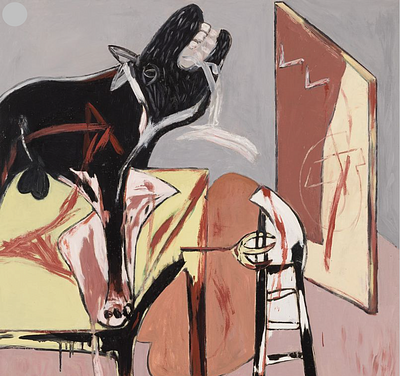JOAN MIRÓ I FERRÀ (Barcelona, 1893 - Palma de Mallorca, 1983). "Montroig 4", 1974. Lithograph on Guarro paper, copy 26/30.
Lot 70
About Seller
Setdart Auction House
Carrer Aragó 346
Barcelona
Spain
Setdart Subastas was born in 2004 and is currently the first online art auction in Spain with solidity, prestige and reliability guaranteed by our more than 60,000 users. Setdart has a young, dynamic and enterprising team ready to successfully manage the purchase and sale of art works through custom...Read more
Estimate:
EUR€5,000 - EUR€6,000
$5,376.34 - $6,451.61
Absentee vs Live bid
Two ways to bid:
- Leave a max absentee bid and the platform will bid on your behalf up to your maximum bid during the live auction.
- Bid live during the auction and your bids will be submitted real-time to the auctioneer.
Bid Increments
| Price | Bid Increment |
|---|---|
| EUR€0 | EUR€10 |
| EUR€200 | EUR€25 |
| EUR€500 | EUR€50 |
| EUR€1,000 | EUR€100 |
| EUR€3,000 | EUR€200 |
| EUR€5,000 | EUR€500 |
| EUR€10,000 | EUR€1,000 |
| EUR€20,000 | EUR€2,000 |
| EUR€50,000 | EUR€5,000 |
About Auction
By Setdart Auction House
Nov 16, 2021
Set Reminder
2021-11-16 08:00:00
2021-11-16 08:00:00
America/New_York
Bidsquare
Bidsquare : Contemporary and Actual Art
https://www.bidsquare.com/auctions/setdart-auction-house/contemporary-and-actual-art-7839
Setdart Auction House sofia@setdart.com
Setdart Auction House sofia@setdart.com
- Lot Description
JOAN MIRÓ I FERRÀ (Barcelona, 1893 - Palma de Mallorca, 1983). "Montroig 4", 1974. Lithograph on Guarro paper, copy 26/30. Ediciones Polígrafa, Barcelona. Signed and numbered in pencil in the lower margin. Work published in "Miró lithographer", vol V, pg 93, ref. 956. Provenance: Masterworks Fine Art Gallery Oakland California, private collection Vancouver, Canada. Measurements: 75.5 x 55.5 cm; 98 x 78.5 cm (frame). This is an exclusive work because it is only 30 copies, and above all it is emblematic in that its title refers to Montroig del Camp, the Catalan village linked to Miró's childhood and an essential emotional landscape for the gestation of his work. Joan Miró was trained in Barcelona, and made his individual debut in 1918, in the Dalmau Galleries. In 1920 he moved to Paris and met Picasso, Raynal, Max Jacob, Tzara and the Dadaists. There, under the influence of surrealist poets and painters, he matures his style; he tries to transpose surrealist poetry to the visual, based on memory, fantasy and the irrational. His third exhibition in Paris, in 1928, was his first great triumph: the Museum of Modern Art in New York acquired two of his works. He returned to Spain in 1941, and that same year the museum dedicated a retrospective to him that would be his definitive international consecration. Throughout his life he received numerous awards, such as the Grand Prizes of the Venice Biennale and the Guggenheim Foundation, the Carnegie Prize for Painting, the Gold Medals of the Generalitat de Catalunya and the Fine Arts, and was named Doctor Honoris Causa by the universities of Harvard and Barcelona. His work can currently be seen at the Joan Miró Foundation in Barcelona, as well as at the Thyssen-Bornemisza Museum, the MoMA in New York, the Reina Sofía Museum in Madrid, the National Gallery in Washington, the MNAM in Paris and the Albright-Knox Art Gallery in Buffalo.
- Shipping Info
-
In-house shipping available. Please inquire at admin@setdart.com.
-
- Buyer's Premium



 EUR
EUR CAD
CAD AUD
AUD GBP
GBP MXN
MXN HKD
HKD CNY
CNY MYR
MYR SEK
SEK SGD
SGD CHF
CHF THB
THB














